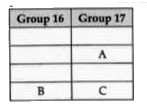Complete Solutions to EXERCISE of chapter PERIODIC CLASSIFICATION OF ELEMENTS of Class 10 book with complete answers and questions
| Class 10 | CHEMISTRY |
| Chapter | PERIODIC CLASSIFICATION OF ELEMENTS |
| CPC CAMBRIDGE PUBLICATION | EXERCISE |
| Number Of Questions | 10 |
| Academic Year | 2023-24 |
Which of the following statements is not a correct statement about the trends when going from left to right across the periods of the periodic table?
View SolutionElement X forms a chloride with the formula `XCI_2` which is a solid with a high melting point. X would most likely be in the same group of the periodic table as
View SolutionWhich element has :
(i) two shells, both of which are completely filled with electrons ?
(ii) the electronic configuration, 2, 8, 2.
(iii) a total of three shells, with four electrons in its valence shell ?
(iv) a total of two shells, with three electrons in its valence shell ?
(v) Twice as many electrons in its second shell as in its first shell ?
View SolutionWhat property do all elements in the same column of the Periodic Table as boron have in common?
View SolutionAn atom has electronic configuration 2, 8, 7
what is the atomic number of this element ?
View SolutionThe position of three elements A, B and C in the periodic Table is shown below:

(a) State whether A is a metal or non-metal
(b) State whether C is more reactive or less reactive than A
( c) Will C be larger or smaller in size than B?
(d) Which type of ion, cation or anion, will be formed by element C?
View SolutionNitrogen (atomic number 7) and phosphorous (atomic number 15) belong to group 15 of the periodic table. Write the electron configurations of these two elements. Which of these is more electronegative?
View SolutionHow does the electronic configuration of an atom related to its position in the modern periodic table ?
View SolutionIn the modern periodic table, calcium (atomic number 20) is surrounded by elements with atomic numbers 12, 19, 21, and 38. Which of these have physical and chemical properties resembling calcium?
View SolutionCompare and contrast the arrangement of elements in Mendeleev's periodic table and the Modern Periodic Table.
View Solution
EXERCISE questions and complete solutions for chapter PERIODIC CLASSIFICATION OF ELEMENTS of CAMBRIDGE CHEMISTRY (KANNADA ENGLISH) of Class 10